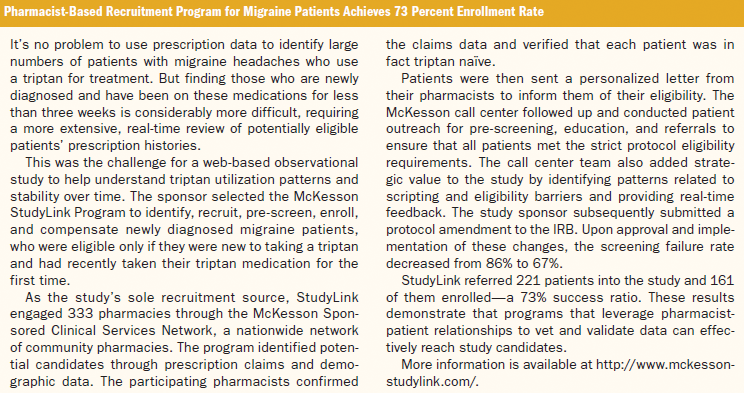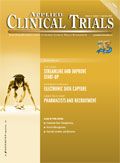Right Time, Right Channel
Applied Clinical Trials
Industry news focusing on the people and organizations who work in the clinical trials profession.
Timely patient recruitment is widely acknowledged to be the single most important aspect of successful clinical trials.1, 2 Yet delays hamper almost 85% of all Phase II–IV clinical trials, bloating budgets and extending the waiting time before the public can take advantage of new medications that might improve or save countless lives. And since prescription drugs have a limited period of product exclusivity, shortening clinical trial times by just one month can generate as much as $40 million in additional sales revenue.3

Several factors play a role in decelerating the patient recruitment process. Study protocols are becoming increasingly complex, adding more layers to the recruitment funnel. The shotgun targeting approach used in some recruitment strategies can be like searching for needles in a field of haystacks. Lack of awareness about trials is another stumbling block. One study of more than 1,000 US adults found that only one in three had even heard of clinical trials.4 In addition, public confidence and trust in clinical research have been steadily eroding for decades.5 Lastly, both the number and size of clinical trials are growing rapidly, creating an unmet demand for more and more patients, including many in diverse, difficult-to-reach populations.
In 2010, clinical study sponsors, investigators, and their partners spent more than $2.3 billion on patient recruitment, and such expenditures are growing 15% annually.3 Despite these efforts, two-thirds of investigator sites fail to meet the patient enrollment requirements for a given clinical trial, according to the Tufts Center for the Study of Drug Development.6
Given these conditions, it's no surprise that the clinical research industry is looking for new ideas. An innovative, patient-centric strategy showing considerable promise involves leveraging pharmacies as a recruitment channel. With their access to and personal knowledge of patients and their medications; pharmacists are uniquely qualified to add value to the targeting and overall effectiveness of patient recruitment initiatives.
Expanding role of pharmacists in healthcare
The pharmaceutical industry has dabbled with using pharmacists for patient recruitment since the mid-1990s. Most of these programs involved little more than notifying a pharmacy's patients by letter that they might be eligible for a nearby clinical trial. Despite their modest scope and lack of patient follow-up, these programs demonstrated the potential value of leveraging pharmacists.
"We knew pharmacies were a great place to recruit. And from the perspective of sponsors and clinical research organizations, these early projects did quite well in cutting the time needed for targeting," says Scott Ballenger, President of the Trial Acceleration Institute, who was involved in some of these early projects. "The retail chains, however, viewed them as more of a distraction to their pharmacists than as an opportunity. So when HIPAA came along a few years later, they didn't want to be bothered with trials."
"Pharma companies were excited about the idea of leveraging this data as a proxy for identifying underlying medical conditions," says John Benbrook, CEO and President of MMG, a patient recruitment and retention firm. "But even though some programs achieved a modicum of success, companies' interest in this approach waned once they realized that this data was not the next silver bullet."
Recent developments have spurred the industry to re-examine the viability of pharmacies for a variety of health-related programs. With a precipitous drop in consumer spending caused by the economic recession, pharmacies began to not just welcome but seek out opportunities to reinforce their patient relationships while creating new revenue streams. In addition, pharmacists are coming out from behind the counter to play a more active role in counseling and caring for patients due to several factors, including:
- Aging baby boomers with chronic conditions
- More people becoming eligible for prescription coverage under the Affordable Care Act
- A growing shortage of primary-care physicians
- Studies that show interventions by pharmacists save money and curb hospitalizations7
Speaking to the evolving role of pharmacists in healthcare, Brian Gallagher, Senior Vice President of Government Affairs for the 250,000-member American Pharmacists Association, recently commented, "If we [as a nation] want to increase healthcare access and quality and decrease cost, pharmacists can do both at the same time. We're focusing on medication therapy management—more than just counseling—that can play an integral part of managing chronic disease over the course of a person's lifetime."8
The limited capacity of clinical trial sites and investigators, coupled with high demand for more patients and more diverse patient populations, is opening new doors for pharmacists. Today, according to Ballenger, pharmacy-based clinical trial programs are growing rapidly, and pharmacists have been involved in clinical trial assessments, survey administration (e.g., patients' perceptions about pain), and even enrollment. Novartis has talked about plans to introduce a program called "Clinical Trials of the Future" in Walgreens pharmacies. According to a blog written by Novartis CEO Joe Jimenez, the idea is for Walgreens, which has more than 7,700 US pharmacies, to make it easier for trial participants to remain in clinical studies.
"This approach would enable clinical trial patients to visit their local Walgreens for routine checks of some vital signs like blood pressure, reducing the need to travel to testing centers that may be far away, potentially speeding clinical timelines and reducing costs," Jimenez explains.9
Yet perhaps the most promising immediate opportunity for pharmacists in clinical trials is to serve as educators and facilitators for patient recruitment. Research has shown that several factors relating to patient access, trust, knowledge, and engagement make pharmacists an ideal channel to expedite enrollment of qualified patients.
Trusted, willing educators
As noted, significant barriers to recruitment include the general public's lack of awareness and education concerning clinical trials and its wariness concerning the clinical trial profession. For example, a 2007 Harris Interactive poll found that more than four in 10 Americans distrust pharmaceutical and biotechnology companies.5 Pharmacists can help bridge the education gap and provide the antidote to rebuild trust.
Major international opinion polls indicate that pharmacists are one of the most trusted sources for health-related information.10 In Gallup's annual honesty and ethics survey last year covering 21 professions, pharmacists ranked second only to nurses and ahead of physicians — the ninth consecutive year they ranked in the top three.11
Moreover, both the general public and pharmacists want the profession to be more proactive in disseminating information about clinical trials. Market research conducted by the Center for Information and Study on Clinical Research Participation (CISCRP) revealed these two key findings:
- Nearly 80% of respondents would like their pharmacists to tell them about clinical trials, yet only 1% reported receiving this information from their pharmacists.
- In the pharmacist portion of the survey, 56% of respondents said they would be very willing to provide trial information to interested patients/customers.12
"The pharmacy channel is ripe for clinical research education, outreach and recruitment, but until now hasn't been accessed to its full potential," says Ken Getz, Board Chairman of CISCRP and Senior Research fellow at the Tufts Center for the Study of Drug Development. "The decision to participate in clinical trials is not one a patient typically makes alone. The results of CISCRP's recent research suggest that people consider community pharmacists a trusted resource, and that these pharmacists serve as an important educational channel that may affect their decision to participate."
Patient knowledge and insights
In a perfect world, a patient recruitment program would be finely tuned to accomplish both precision targeting (geographic and therapeutic) and sufficient patient volume. The former accelerates the screening process by selecting better-qualified candidates, while the latter ensures the study has enough candidates to meet its enrollment goals. In the real world, however, study sponsors, professional recruitment organizations and investigators often seem to have only two recruitment options: either use a scalpel for precision (i.e., through investigator sites), or a blunt instrument for volume (i.e., direct-to-patient mass-media advertising).
Pharmacy-based recruitment programs can combine precision with reach. Volume is certainly not an issue; there are more than 61,000 pharmacies in the United States, of which 34% (more than 20,000) are independent community pharmacies.13 These independents on average fill 64,000 prescriptions a year and can be accessed and utilized in aggregate through specialized pharmacy networks. Community pharmacists generally have stronger relationships with patients, which make them well-suited to vet potential candidates.
Pharmacists are also in a unique position to expedite targeting and enable studies to quickly "fill the funnel" with high-quality, pre-qualified potential participants. Geo-targeting obviously can be extremely precise—a major benefit since distance to a clinical trial site is a determinant as to whether patients participate in a trial (a 30-mile radius is the upper limit for most indications except cancer).3 Therapeutic targeting also can be greatly refined. Pharmacists' customer databases are brimming with rich, privacy-protected data to target patients with specific diagnoses and co-morbidities, enabling studies to filter candidates based on protocol inclusion/exclusion criteria.
Yet while patient data has always been the allure of pharmacy-based recruitment programs, what really excites industry professionals about this channel is its potential to become truly patient-centric. Pharmacists are the most accessible healthcare providers in the country: Americans visit pharmacies at more than five times the annual rate at which they visit their primary and specialty care physicians combined.14 Each of these interactions is an opportunity for clinical trial education and, more importantly, gives pharmacists a chance to interact with and learn about their patients. For community pharmacists, these relationships set them apart from the chains and can be instrumental to their long-term success. "What's sometimes neglected in recruiting strategies is the fact that patients are people," says Benbrook. "The idea of combining data with pharmacist engagement and patient interaction is an exciting concept."
For example, the McKesson StudyLink program (see sidebar) is designed to leverage the patient knowledge and insights of 2,500 independent community pharmacies whose patient programs McKesson contractually supports. After doing the first cut of eligibility screening based on geographic proximity (when applicable) and prescription claims data, McKesson sends a list of potential candidates to pharmacists to remove those whom they consider inappropriate. The reasons for exclusion often cannot be inferred using prescription history, and require knowledge that only the pharmacist would have. For example, one candidate may recently have become pregnant; another might be on a medication for a different indication than what the records show; others may have mobility, language, or personality barriers that would make them a poor fit for certain trials.

"My background is in the group practice environment, and this approach is similar to how we find patients by applying filters to medical records," says Brenda Drake, Director of Business Development, Chase Medical Research, who intends to use StudyLink for an upcoming patient recruitment effort. "It's helpful to go beyond the raw data, because even medical records aren't necessarily an accurate reflection of what's really happening. We know, for example, that patients don't always take their prescribed medications."
Success factors
Since more sophisticated pharmacy-based recruitment programs are relatively new, best practices have not yet been established. Still, the industry's experiences in partnering with pharmacists on compliance and behavioral intervention programs can provide useful guidance. For example, it's critically important for any program to avoid disrupting the dispensing workflow. Other success factors are likely to include:
- A contractual relationship with a sufficiently large network of interested pharmacists to meet volume criteria in different geographic areas.
- Legally compliant access to prescription claims and demographic data with the clinical infrastructure and information technology to systematically identify potentially qualified candidates.
- Active involvement from pharmacists in vetting and validating pre-qualified candidates based on personal knowledge of their customers.
- Patient outreach and proactive follow-up to inform and educate patients about the clinical trial opportunity and to confirm eligibility and interest. (Note: This key step was missing in most of the earlier recruitment programs.)
- An operational infrastructure for training and compensating pharmacists while ensuring compliance with federal and state privacy laws and regulations.
- Ongoing communications to participating pharmacists (e.g., updates on the status of which candidates were enrolled in the study) to keep them informed and engaged.
The ultimate determinant of success for such programs will be their ability to deliver demonstrable benefits. For study sponsors, recruiting firms, and investigators, these programs must accelerate enrollment timelines, reduce costs for pre-qualified referrals, and improve referral-to-enrollment ratios. Tracking performance on these and other metrics will provide a baseline for meaningful assessment.
For pharmacists, evaluating the benefits of participating in a clinical trial patient recruitment program boils down to two simple questions: Is this the right thing to do for my patients? Will this be worth my time? Research shows that the public wants more information about clinical trials, with analysis indicating that chain pharmacy users are 26% less likely to be very or somewhat interested than users of locally owned community pharmacies.12 As to the second question, the answer will depend not just on the compensation pharmacists receive but also on the effectiveness of these programs in promoting and strengthening customer relationships as a key tactic in gaining a competitive edge in their local markets.
Experience with a number of pharmacy-based programs show that many pharmacists find it professionally rewarding to apply their clinical expertise and customer knowledge. Forward-thinking pharmacists such as Tim Davis, the chairman of the National Community Pharmacists Association's Committee for Innovation and Technology, are embracing new roles and opportunities available through industry partnerships.
"Pharmacies are a critical node in our healthcare system for the collection, distribution, utilization, and management of data," says Davis, the President of the Revolution Rx consulting firm and the owner of two Pittsburgh area pharmacies, which were both part of a patient recruitment program for a migraine study (see sidebar). "Any programs that will help pharmacists leverage data in new ways, promote better healthcare for patients, and generate revenue streams are extremely valuable to the participants and our profession."
Kevin Winston, the owner of Sutcliffe Pharmacy in Chicago, cites one more reason for his involvement with clinical trials. "Educating and recruiting patients for clinical trials is personally and professionally rewarding," he says. "It's satisfying to know you're making a difference in your customers' lives."
A balm for a chronic pain point
With clinical trials becoming larger and increasingly complex, demand for patients will only intensify. Overcoming enrollment challenges will require innovative, multi-faceted recruitment strategies.
Pharmacy-based patient recruitment programs can be part of the solution. As a complement to more traditional tactics, they can be a balm to help soothe the trial process' chronic pain point—delays caused by an inability to precisely target and qualify a sufficient number of patients. Pharmacists are motivated to be a conduit for such programs, and patients want to know more about clinical trials. While it's important to be realistic about goals and expectations, results suggest that pharmacy-based recruitment strategies could see high rates of success.12
Steve Hoffman, is Senior Vice President, Chief Pharmacy Officer at McKesson, 4343 N. Scottsdale Road, #370, Scottsdale, AZ, e-mail: [email protected].
References
1. M. A, Rojavin, "Recruitment Index as a Measure of Patient Recruitment Activity in Clinical Trials," Contemporary Clinical Trials, 26 (5) 552–556. (2005).
2. K. B. Drennan, "Patient Recruitment: The Costly and Growing Bottleneck in Drug Development," Drugs Discovery Today, 7 (3) 167–170 (2002).
3. C. Mintz, "Social Media's Impact on Clinical Trial Enrollment," Life Science Leader, (2010), http://www.lifescienceleader.com/magazine/past-issues3/item/3584-social-media's-impact-on-clinical-trial-enrollment?list=n.
4. "Evaluation of Patient Recruitment Strategies—Phase I Feasibility Study" CSR, Incorporated, (2006), http://aspe.hhs.gov/evaluation/fullreports/06/8384.pdf.
5. K. Getz, "Public Confidence and Trust Today: A Review of Public Opinion Polls," The Monitor, 9, 17–21 (2008).
6. Tufts Center for the Study of Drug Development, "Drug Developers Actively Improving Efficiency of Clinical Trials," http://csdd.tufts.edu/news/complete_story/rd_pr_apr_2011.
7. T. Wilemon, "Pharmacists Take on Expanded Role to Help Fill Healthcare Void," The Tennessean,http://www.tennessean.com/article/20120805/NEWS0⅓08050051/Pharmacists-take-expanded-role-help-fill-health-care-void.
8. S. Stephens, "The Evolving Role of Pharmacists," (2012) http://career-news.allhealthcarejobs.com/2012/05/15/the-evolving-role-of-pharmacists.
9. E. Silverman, "Novartis and Walgreens to Team on Clinical Trials," (2012), http://www.pharmalot.com/2012/03/novartis-and-walgreens-to-team-on-clinical trials/.
10. K. A. Getz, "Engaging Pharmacists in Research Education," Applied Clinical Trials, 19 (7) 30-32 (2010).
11. NACDS News Release, "For Ninth Consecutive Year, Pharmacists Ranked in Top Three in Gallup Integrity Survey," (2011) http://www.nacds.org/wmspage.cfm?parm1=7279/.
12. D. Simmons, et al., "Are Pharmacists a Viable Channel for Education About Clinical Trial Participation?" Drug Information Journal, 45 (4) 443–453. (2011).
13. "2010: A Good Year for Independent Pharmacies," Drug Channels, http://www.drugchannels.net/2011/09/2010-good-year-for-independent.html.
14. Wilson Health Information, WilsonRX Pharmacy Satisfaction Survey. (Wilson Health Information, New Hope, PA, 2008).

Improving Relationships and Diversifying the Site Selection Process
April 17th 2025In this episode of the Applied Clinical Trials Podcast, Liz Beatty, co-founder and chief strategy officer, Inato, discusses a number of topics around site engagement including community-based sites, the role of technology in improving site/sponsor relationships, how increased operational costs are impacting the industry, and more.
Behind the Buzz: Why Clinical Research Leaders Flock to SCOPE Summit
February 7th 2025In this episode, we meet with Micah Lieberman, Executive Conference Director for SCOPE Summit (Summit for Clinical Ops Executives) at Cambridge Innovation Institute. We will dive deep into the critical role of collaboration within the clinical research ecosystem. How do we bring together diverse stakeholders—sponsors, CROs, clinical trial tech innovators, suppliers, patients, sites, advocacy organizations, investors, and non-profits—to share best practices in trial design, program planning, innovation, and clinical operations? We’ll explore why it’s vital for thought leaders to step beyond their own organizations and learn from others, exchanging ideas that drive advancements in clinical research. Additionally, we’ll discuss the pivotal role of scientific conferences like SCOPE Summit in fostering these essential connections and collaborations, helping shape the future of clinical trials. Join us as we uncover how collective wisdom and cross-industry partnerships are transforming the landscape of clinical research.